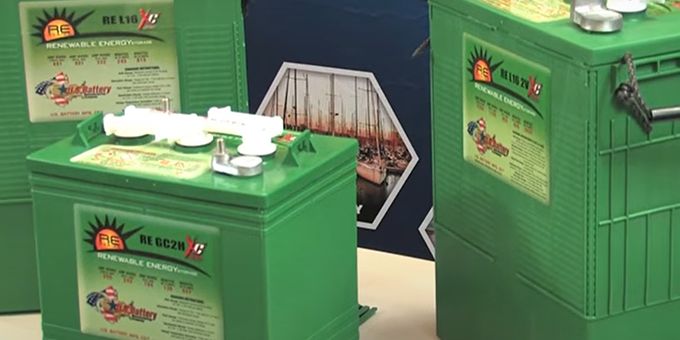Advancements in battery chemistry and design have allowed deep-cycle batteries to deliver longer cycle life and higher capacity and cycle-up to full rated capacity faster than previous designs.
 Understanding the Chemistries of Deep-Cycle Batteries
Understanding the Chemistries of Deep-Cycle Batteries

Article from | US Battery
Most industries and consumers who have switched to using alternative energy sources understand that deep-cycle batteries are key for proper energy storage. As the need for energy storage increases at various levels from a remote cabin to residential homeowners, or full-industrial power systems, questions often arise concerning such as why some batteries need more maintenance than others or why some have longer operating times between charges. Recharging batteries using solar or wind power always depends on Mother Nature and is therefore unpredictable. In addition, overall performance and runtime will vary with the size of the battery pack and the battery chemistry.
Some might think the types of batteries used in this equipment haven’t changed in decades, however, the truth is that there have been many improvements. Advancements in battery chemistry and design have allowed deep-cycle batteries to deliver longer cycle life and higher capacity and cycle-up to full rated capacity faster than previous designs. With three basic battery chemistries available, it can be challenging to determine which one is the best for your particular application and which one will provide the best performance.
Previously, there were two main types of deep-cycle batteries; flooded lead-acid (FLA) and absorbed glass mat (AGM). Today, lithium-ion (Li-Ion) batteries are also available in the market. This brings even more questions and a variety of products from which to choose. Because all three types provide certain advantages and disadvantages, it is important to understand how they can be optimized for a given application.
Flooded lead-acid batteries are still the most popular and cost-effective in most alternative energy applications where energy storage is needed. Improvements to this over 150-year-old technology include enhanced positive electrodes using tetrabasic lead sulfate crystals that are formed in a more uniform structure. This increases initial capacity, provides faster cycle-up to peak capacity, and improves cycle life.
The basic design of an FLA battery has the electrodes submerged in a liquid aqueous electrolyte. During use, water in the electrolyte is lost from electrolysis during charging and must be replaced. This requires regular maintenance in the form of water replacement and cleaning and re-tightening terminals. Maintenance also includes keeping the batteries fully charged to prevent sulfation and to avoid freezing in cold weather. The advantages of FLA batteries are that they are safe, reliable, low-cost, and offer a wide range of capacities. They are also essentially 100% recyclable – the highest in the industry.
AGM batteries have the electrolyte absorbed in special glass mat separators that surround the battery’s electrodes and immobilize it. This allows the battery to be sealed with a special one-way valve to control gassing and water loss. This eliminates the need to add water for true maintenance-free operation. This also prevents electrolyte leakage in even the most extreme conditions. AGM batteries are more expensive than FLA batteries but they are an excellent option in applications in which the batteries are difficult to access for regular maintenance. AGM design advancements in positive electrode corrosion resistance and carbon-enhanced negative active materials have improved their charge acceptance in a partial state of charge applications and have increased cycle life over previous models. AGM batteries are also essentially 100% recyclable.
Lithium-ion batteries are newer to the market than the previous two chemistries and, while they were initially much higher in cost per watt-hour, ongoing cost reductions and improvements have made them more affordable. When first launched, Li-Ion battery packs required separate battery management systems (BMS) and special cell packaging for cooling. New pack design improvements now have the BMS built into the battery pack with standardized cell packaging, eliminating the need for separate electronics or special chargers in most applications.
Deep-cycle Li batteries typically demonstrate increased average cycle-life over FLA and AGM batteries (from 2,000 to 5,000 cycles) and, unlike other chemistries, they can be discharged beyond 50-percent Depth of Discharge (DOD) without reducing cycle life. Lithium batteries also do not require special maintenance and are lighter than FLA or AGM batteries in comparable applications. Lithium batteries also come at a higher initial cost than FLA and AGM chemistries and currently, lithium-ion batteries are not easily recyclable and require special, costly disposal methods.
Selecting among FLA, AGM, or Li batteries ultimately depend on the application and budget for the type of system in which they are installed and on the amount of energy storage required. Battery manufacturers such as U.S. Battery have a complete information library on these battery products with applications, recommendations, and cycle-life ratings to compare and allow you to decide what’s best for your application.
The content & opinions in this article are the author’s and do not necessarily represent the views of AltEnergyMag

US Battery
Since 1926, we have been designing and manufacturing the highest quality deep cycle batteries in the world. Starting out as a small manufacturing operation in San Diego, California and growing to the global company that you see today, having locations in Corona, California, Evans, Georgia and Augusta, Georgia, we work each day to supply our customers with the best batteries available. Through innovation and technology our products are the go-to energy storage batteries for a variety of applications including: scissor lifts, sweeper/scrubbers, golf carts, boats, RVs, renewable energy, and many other industries that require the constant energy delivered by quality deep-cycle batteries.
Other Articles
Selecting the Right Deep Cycle Battery
Lithium Batteries for Renewable Energy Applications
The Truth About Reviving Dead Batteries
More about US Battery
Comments (0)
This post does not have any comments. Be the first to leave a comment below.
Featured Product

